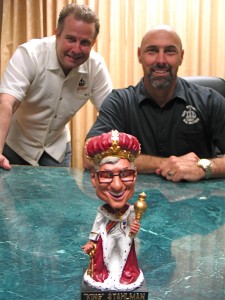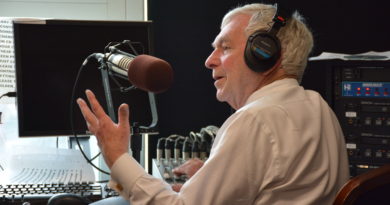The King: Still holding court over the San Diego bail bonds kingdom

The late George ‘The King’ Stahlman’s son and son-in-law continue the marketing wizardry that the famous bail bondsman started years ago
By Kris Grant
“Early to bed, early to rise, work like hell and advertise.”
That was the “King’s” motto, the king of the San Diego bail bonds business, that is. For over six decades, George “The King” Stahlman ruled over the San Diego kingdom of get-out-of-jail, maybe not free, but “quickly, affordably and discretely.” And his image was everywhere — on television, billboards, the company Website, bus benches and Yellow Cabs.
And there it remains.
The king died on Feb. 13, 2009, at age 85 of emphysema in his Del Cerro home. But most San Diegans, especially those who might be in need of a bail bond, would never know it.
That’s because the king still reigns, and never missed a beat in advising the masses that it’s “Better to know me and not need me than to need me and not know me.”
Today, his son, George Stahlman Jr., known around the office as “Junior,” is co-owner of the company along with the Stahlman’s son-in-law, Mike Hardwick, husband to daughter Cara Mia. The second generation has decided that Dad’s legacy — and image — will live on, well into the future.
Cara Mia even takes Dad’s Caddie, with its personalized license plate “BAIL KNG” out for a spin now and then.
There are also King Stahlman bobble-head dolls, matches, key chains and, for the latest in couture, King Stahlman T-shirts, sure to grab admiring glances at the country club.
“The T-shirts are the hottest sellers in San Diego County,” says Junior, noting that they aren’t really sellers, but giveaways. “People come into our offices every day asking for them.”
The bobble-head dolls, depicting King Stahlman in majestic flowing robe and wearing a crown, were Hardwick’s idea.
“I had no idea when I married Cara Mia that I’d one day be working in this business,” Hardwick confesses, explaining that he had been an orthopedic device sales representative for 17 years prior to joining his father-in-law’s firm. “I traveled all over the country and spent a lot of time in operating rooms. There’s absolutely nothing similar about these businesses,” and then he cracks a joke about dealing with “criminals,” but there’s a twinkle in his eye that lets one know he enjoys the work and maybe, just maybe, has that same outrageous sense of good humor as the King.
King Stahlman is not the first icon to have been summoned from the afterlife to continue marketing a product.
Popcorn king Orville Redenbacher was digitally raised from the dead in 2007. Redenbacher, too, enjoyed longevity, passing away in his Coronado home in 1995 at age 88. Con-Agra Foods, the conglomerate that owns the gourmet popcorn, used digital imagery to manipulate Redenbacher’s image into new settings, including one ad showing Redenbacher using an I-Pod. The ad agency then recruited an actor whose voice was a dead-ringer (pardon the phrase) for Orville’s. And, voila, with his signature horn-rimmed black glasses, the popcorn king was back in the modern age.
The bail bond king also had a striking iconic appearance, again with snow-white hair and heavy-duty black glasses.
Junior says his father was in life just as he appeared in his ads. “He was very gregarious with a great sense of humor, citing one of his Dad’s favorite giveaways: a bumper sticker reading “My child was Citizen of the Month at King Stahlman Bail Bonds.”
Stahlman was a long-time smoker, often photographed with a cigarette in hand, and his voice carried a telltale smoker’s raspy edge. Smoking may have been a stress relief valve for a guy who worked round the clock, monitored his offices from his home via surveillance cameras.
“Right up until the end, he was going full speed all the time,” Junior continues. “He was a tough old guy, and quite honestly, was nicer to be friends with than to work for.”
Junior should know: he began working at his dad’s company, “Just hanging around the office” when he was 17. Today he, along with the other 22 employees at King Stahlman, each work 12-hour shifts, Junior wisely choosing the 7 a.m. to 7 p.m. duty. All five offices – two in Downtown San Diego, others in Chula Vista, Vista and Santee — are open 24 hours a day, 7 days a week. Business is fairly steady both a.m. and p.m., mirroring times crimes are committed.
In 2004, Stahlman estimated the amount of the company’s annual bonding at approximately $60 million; today, Junior Stahlman estimates it at slightly less than $50 million.
He says the decrease in volume is not a reflection of less crime in the area, but the growing number of bail bonds firms. “In 1994 there were about eight firms in San Diego,” he says. “Today, there are more than 80 licensed bonding agencies.”
The company can post bail for clients anywhere in the United States and Puerto Rico. Still, there must be some connection to San Diego, Junior says, most likely a parent who lives here posting bail for a son or daughter living in another city or state.
The elder George Stahlman, fresh out of the Navy where he earned a Purple Heart during the battle of Guadalcanal during World War II, began working as a “gopher” assistant in the Los Angeles bail bond business of Schwind and Spielberg. “Dad was an old-school, hard-line guy who broke into the business back in the gangster days, the days of Bugsy Siegel,” Junior relates. One time, his boss asked Stahlman to entertain two of the firm’s clients from Chicago. Later that week he saw a newspaper photo of the pair, dead, shot with bullets in their heads.
In 1952 Stahlman set up his own bail bond firm in Oceanside, then sold it and opened in Downtown San Diego
Today’s bail bond business isn’t nearly as unseemly as those rough-and-tumble postwar years in L.A., but it does have its challenges, says Junior, who cites some irksome would-be competitor companies that offer “no money down” bail and others that are handing out business cards inside jails and offering payoffs for clients — the latter two practices strictly illegal. “They’re basically living up to the reputation that hounds the industry,” he says with wry displeasure.
Still, at King Stahlman, business is good, Junior attests. No, that doesn’t mean that crime is up. Rather “It’s the legacy that my father left,” he says with pride. “We feel we give exemplary service. It’s a family business with a family feel. We get calls from people who have lived here all of their lives and they know our name.”
The bail bond business has been around as long as the country. The Eighth Amendment of the U. S. Constitution, bannered on King Stahlman’s Website, states that “excessive bail shall not be required, nor excessive fines imposed, nor cruel and unusual punishments inflicted.”
Today, more people may need to post bail than ever before. For example, last year, if a first-time DUI offender was hauled into jail, he would simply be held until he sobered up and then released with a court appearance date. This year, first-time DUI offenders need to post bail in the amount of $2,500.
That new rule is part of this year’s bail schedule for San Diego County. Each year, local judges gather to assess bail bond fees. Today’s bail schedule reads like a menu for various offenses: possession of drugs runs $5,000; a misdemeanor domestic violence charge is $10,000. “So, let’s say someone gets in a fight with his wife and the wife calls 9-1-1,” says Junior. “The police pick up the guy driving a stolen car and there are drugs in the car. That’s three offense with a total bail of $25,000.”
In most cases, a family member of the person in custody becomes the co-signer for the total amount of the bail. King Stahlman Bail Bonds has financial criteria that must be met before they’ll finance bail. “We’re just like a bank that lends money,” Junior says.
The younger Stahlman says the target market for bail bonds is broad: “It’s 18 to 80 and it covers everything. Drunk driving, domestic violence, theft, drugs – anything and everything.”
The King Stahlman company Website (www.kingstahlman.bail) includes a “Careers in Bail Bonds” button, a career that isn’t often included in too many high school or college career counseling offices.
Junior says that his firm included the career button in self defense, stemming from the numerous calls received from people who asked about the possibilities of bounty hunting. “If I took all those calls I wouldn’t get any work done,” Junior groused. “Everybody wants to be a bounty hunter.”
Bail bondsmen must be licensed by the state, a process that requires about five months, and Stahlman won’t interview anyone without a license.
And as for bounty hunting, it’s a whole new cyber ballgame.
Yes, there are still bail skippers and many in San Diego head across the Mexican border. Junior says his firm “farms everything out” to locate and apprehend the skippers.
“We have two guys who do most of the work for us,” he says, referring to the associates not as bounty hunters but as “recovery agents.”
“No, they don’t look like the guy on TV (Dog, the Bounty Hunter),” Junior says. “Nowadays, most of the leads and investigation is done in the cyber world — reviewing cell phone records and finding people on the Internet. “Still, there comes a time when you have to put your hands on the people.”


